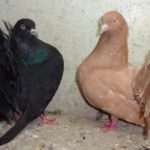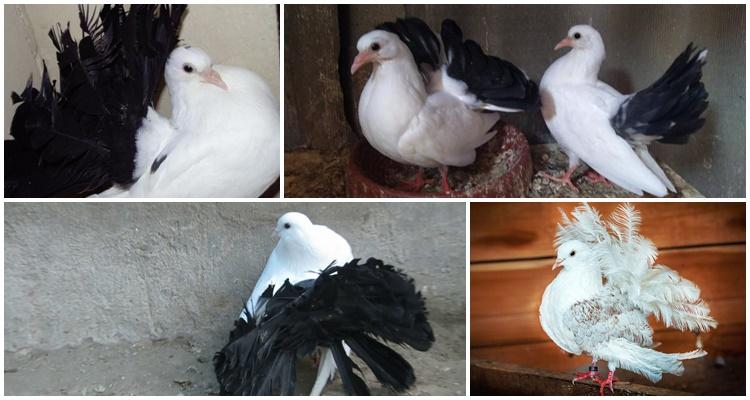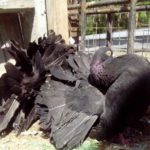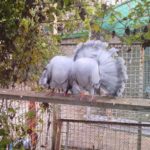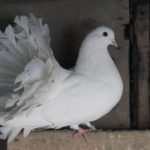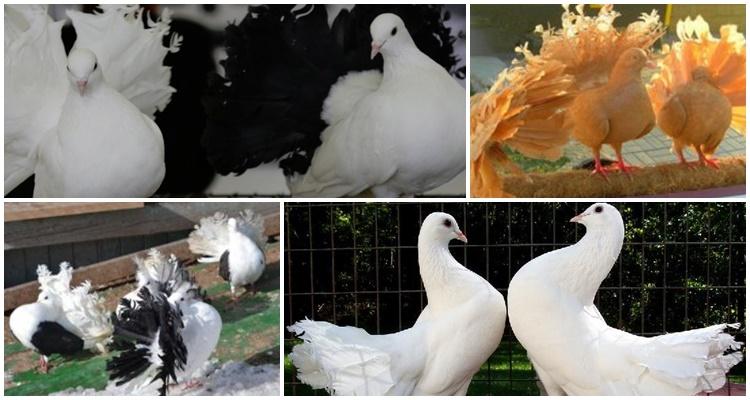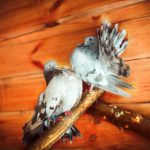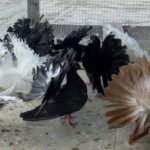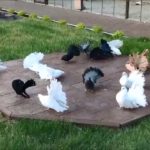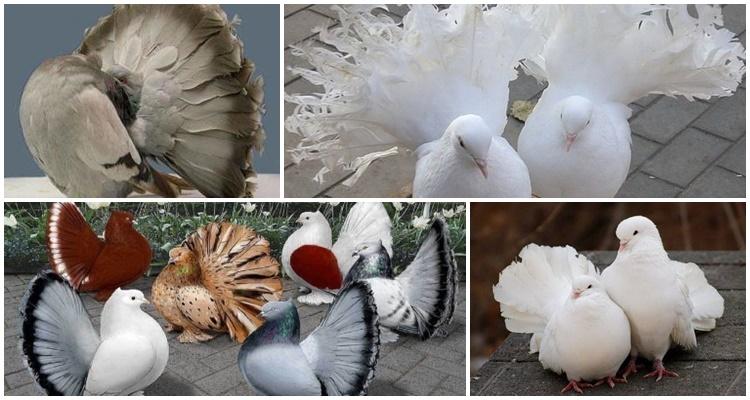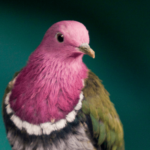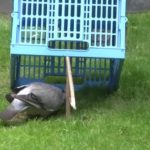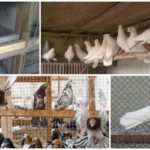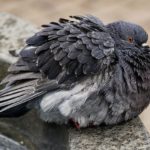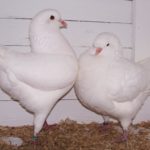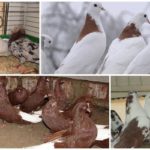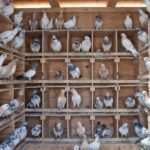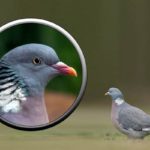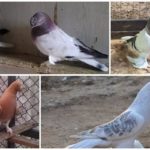The breed of peacock pigeons is named because of its main feature - the tail feathers of the birds are not folded together, as usual, but diverge to the sides, which is why the tail takes on the appearance of a peacock. Due to the unique appearance of pigeons, poultry farmers choose them for breeding as an ornamental breed. Let's consider the description and key characteristics of peacock pigeons, their advantages and disadvantages, features of keeping, nutrition and breeding.
Origin story
The time of breeding of the breed dates back to the 16th century, then the bird phenotype had already formed, which is inherited by them today. The breed is believed to originate from India. During colonial rule of the country, the British took the birds to England, where they continued to work with the breed.
Here the modern form of peacock pigeons and 2 branches with some differences in phenotype were obtained - English and Scottish. The breed came to Russia in the 19th century, by which time the birds had acquired an elegant body shape.
Description and characteristics of the breed
Purebred peacock pigeons have many colors; they can be variegated, plain white (according to the breed standard - the main color), black and have other colors. The head of the breed is small, thrown back, and the neck is arched. The body is rounded and sways when the bird walks. Peacock pigeons have a curved thin beak, its color matches the color of the eyelids.
The pupil can be light or dark, its color depends on the color of the plumage. The chest of peacocks is spherical, convex, with a short concave back. The legs are without feathers, red, the ends of the feathers on the wings are directed towards the tail. The tail is made up of 30-50 feathers tightly spaced, stands vertically, the ends of the lower feathers touch the ground. Birds have a developed rump.
A breed characteristic of peacock pigeons is dissected tail feathers in the upper part. Inadmissible exterior characteristics in the breed are a long thick neck, a large head, and a weak build. The dull color of the plumage is also a disadvantage.
Main positive and negative aspects
Advantages of peacock pigeons:
- original appearance;
- variety of colors;
- unpretentiousness to content;
- developed instinct of hatching and nurturing.
The peacock breed has no particular disadvantages.
Subtleties of maintenance and care
Pedigree pigeons and peacocks must be kept in a separate poultry house, which creates favorable conditions for the development and reproduction of birds. Important maintenance conditions: the pigeons inside the dovecote should not be crowded and should always have access to food and water.
The inside of the poultry house should be kept clean, droppings should be removed, feeders should be cleaned of any remaining feed, and the water should be changed daily. Place a container of sand on the floor. Disinfect the premises as often as possible, but at least 2 times a season: before mating and after the birds molt. While disinfection is underway, pigeons are removed from the dovecote. After the period of action of the disinfectant has expired, the poultry house is ventilated.
The temperature in the dovecote should be within 10-25 ˚С, humidity – 70%. It is impossible for the room to be damp; with high humidity, birds develop fungal diseases and helminthiases. The length of daylight should be within 12 hours; in winter it must be maintained artificially, with the help of lamps. In addition to lighting, they dry the air and warm it up. A small enclosure is set up next to the dovecote where the birds can go for a walk. It is covered with a net and perches are placed inside. Corral area – 1 sq. m. for 2 pigeons.
Diet
The diet of peacock pigeons, which is prepared for them in summer and winter, is different. When it's cold, birds need to get more nutritious food with more energy. In summer, food consists of products that are easily digested; 30-40 g of feed are consumed per pigeon. It is recommended to add finely chopped green grass and protein-containing products to the main grain mixture.
Grain mixtures are prepared from any grain of cereals and legumes; it must be sifted to remove impurities and not damaged by pests.
In early spring, when the mating period of peacocks begins, fat- and protein-containing foods, vitamin supplements, and yeast are introduced into the diet. During the molting period, pigeons are also fed grain, which contains protein necessary for the formation of feathers. For 1 kg of grain mixture add 10 ml of fish oil.
How to breed birds correctly
To breed peacock pigeons, you need to select birds with a good gene pool for your farm. All breeding stock must have a characteristic phenotype, without any defects. Uncontrolled breeding of pigeons is not allowed. To record breeding work, you need to keep a book where you record all selections and their results.
Pair selection
A pair of peacocks is chosen in the spring; it is at this time that pigeons have a decorative appearance. Individuals who will become parents must be healthy and of moderate fatness. Parental pairs are formed according to different principles: homogeneous, when birds are selected according to characteristics that both have, and heterozygous, for which selection is carried out according to different characteristics.
Pairing
Preparation for mating of peacocks begins with the installation of plastic mating boxes in the dovecote. Their dimensions are 70 cm by 50 cm by 40 cm. A partition is placed inside, which forms 2 compartments. The boxes are brightly painted in a variety of colors so that you can know which birds are in which ones.
The mating process looks like this: a pair of pigeons are left in a box intended for them overnight.In the morning they are released to the others, but they watch how the couple behaves. If a male follows a female and cares for her, this means that a pair has formed. After 2 days, a nest is placed, which will soon contain 1-2 eggs.
Incubation
The hatching time for pigeon chicks is 16-19 days. Incubation is carried out by the female, who incubates the eggs in the nest. On the 12th day of incubation, the eggs are checked for the presence of embryos. The eggs are examined using an ovoscope or the contents are examined against the light. By this time, the pigeons inside are already sufficiently formed and clearly visible.
Removal
In female peacock pigeons, the maternal instinct is developed; after successful breeding, they move on to raising offspring. Doves cope well with this task; all the owner needs to do is provide them with adequate food and care. First, the females feed the chicks with crop contents, then they accustom the adult birds to food.
While the pigeons are feeding from their mothers, you need to monitor them to make sure they are all fed. If there are hungry people, you should try to feed them a nutritious mixture made from warm milk and boiled yolk. The chicks are fed this mixture from a pipette.
Only from the age of one month do the chicks begin to be fed with finely ground grain.
Diseases and methods of their treatment
Infectious diseases such as salmonellosis and psittacosis, and adenovirus occur in peacock pigeons. Diseases affect both adult birds and young birds. Sick pigeons should be treated as soon as the infection is discovered. Without treatment, some birds may die. Treatment begins with removing sick pigeons from the poultry house so that they cannot infect others. Each infection has its own therapy, which you can find out about from your veterinarian.
Prevention of viral and bacterial diseases consists of cleaning and disinfecting dovecotes, feeders and drinking bowls. Walking birds in the fresh air helps strengthen the immune system. Proper feeding maintains health and allows birds to develop properly. 1-2 times a year, the livestock is treated for helminths and vaccinated.
Peacock pigeons are a beautiful old breed. Their appearance is so remarkable that it is unlikely to confuse the variety with another. People who are seriously passionate about this breed raise it to produce decorative purebred offspring that can be presented at exhibitions. And for ordinary hobbyists - to decorate the yard and enjoy interacting with birds.

